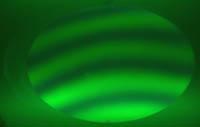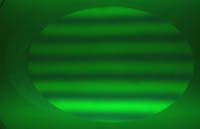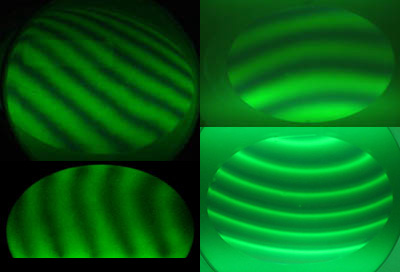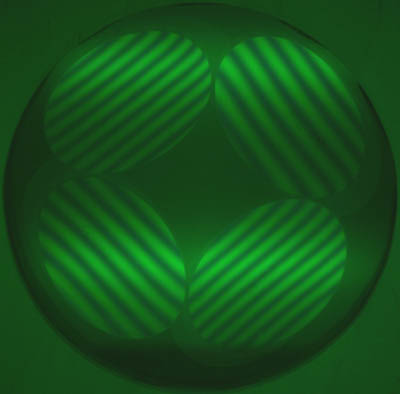| Introduction Elliptical secondary mirrors are an essential part of Newtonian telescopes and Cassegrain telescopes that utilize a Coude or Naysmith arrangement. Being of the proper elliptical shape, they are angled at 45 degrees and are used to reflect light at an angle of (typically) 90 degrees to the optical axis. Ellipticals are sized by the dimension of their minor axis (ma), which is the shortest distance across the center of the flat, and size that it appears when viewed at an angle of 45 degrees. All sizes mentioned here are minor-axis dimensions. The major axis dimension of an elliptical secondary that is meant for use at an angle of 45 degrees is found by multiplying the minor axis by 1.41, or more exactly the square root of 2. My Experiences
I have tested a large number of elliptical flats, ranging in size from 1.5" to 8" ma, using contact interference tests against a reference flat (typically a 10" fused quartz or Zerodur flat). Most tests shown on this page use this test method. I have found that a significant fraction of elliptical flats do not meet the claimed specifications for flatness, mostly regardless of supplier and test method. Additionally, some manufacturers and resellers do not test the entire surface of the secondary mirror. Please note that all images on this page (except for one that was cropped to remove an overexposed region) show the entire surface of the elliptical flat under test.
The images to the left show a 6" flat before final figuring (left column), and the images in the right column show the same flat after figuring. The concavity along both axes has been greatly reduced, and the fringes made significantly more parallel. This flat is now 1/8 to 1/10th wave across its entire surface. The curve in the fringes near the outer edge of the mirror shown in the minor-axis photo is NOT a turned edge, it is actually a high area, as the mirror is still slightly concave in that region. Note also that in the image on the left with fringes oriented along the minor axis, the fringes are more closely spaced than the corresponding image on the right, so the sensitivity is greater in the minor-axis test image at right, and it is a more critical test. So, while some bend remains in the fringes, it is only 1/4-1/5 of the fringe spacing, which corresponds to 1/8 to 1/10th wave of surface error on the glass.
Many flats that I
receive for
testing are quite good. Above are
images of four 3.1" secondaries, with fringes aligned along the major
and minor axes to show flatness in both directions. This shows
they are quite flat along both directions, and this is necessary if
sotware analysis software is not used. Therefore, it is my policy to test, at no charge, the entire surface of any flat secondary mirror that is to be used with a primary mirror that is made or refigured by Lockwood Custom Optics. I will either approve the secondary mirror, or fail it and, at the client's expense, refigure it or obtain a replacement which I will again test. This policy holds for all secondary mirrors that will be used in new Starmaster Telescopes. By doing this, I guarantee that the optics, when properly mounted, aligned, and equilibrated, will perform to their limits (useable powers of 50X per inch of aperture or higher) or to the limits of the atmosphere on a given night. My standard for secondaries is generally 1/8th wave peak-to-valley on the glass, with no sharp slope errors over the main portion of the surface. This guarantees minimal degradation of the wavefront. I refigure larger secondary mirrors for an hourly rate. I prefer to refigure 3.5" and larger secondaries. For bad smaller secondaries, it is often cheaper and simpler to buy a replacement, but that may depend on the type of surface defect. Badly scratched secondaries should be replaced. Why you shouldn't undersize your secondary mirrorIn some cases when elliptical secondaries are manufactured, and in a small number of cases when they are refigured, a small turned edge may develop. This usually occurs on large secondaries, and is due to flexure, the irregular shape of the mirror, and its varying thickness and thermal properties. This is usually not a problem, because the turned portion is completely hidden by the lip of the mirror mounting. If it is not covered, so long as the secondary is sized correctly to fully illuminate a field size larger than 0.25", then the edge is not contributing to the cone of light at the center of the field where optical quality is best. It is also not used at high power when the portion of the field being viewed is fairly small. However, if the object (such as a planet) is allowed to drift across the field, then when it is being viewed off-axis the edge of the secondary will affect the image when lower magnifications are used. Please don't misinterpret this - I am not saying a turned edge is acceptable - it certainly is never acceptable to me on a primary mirror where the entire surface is used. I am simply saying that in some cases, on a secondary mirror, it will be physically hidden, or it will make no difference at all in performance, because the edge of the primary forms the aperture stop of the telescope and the edge of the secondary is not used except for the edge of the field. A large secondary with a generally good surface and a turned edge is an expensive item to refigure, especially if it will result in no perceptable improvement in performance, so the system should be analyzed carefully before proceeding. This is yet another reason why secondary mirrors should be tested, and chosen to be large enough to comfortably illuminate the diameter of fully illuminated field that you require. For visual use I recommend a minimum fully illuminated field diameter of 0.25". Imaging applications will generally require larger illuminated fields, which the telescope designer must calculate. A large table of secondary mirror sizes for various apertures, focal ratios, illuminated fields and focuser heights may be found HERE. |

 Elliptical Flats:
Elliptical Flats: It
is often
assumed that these mirrors
are all made quite flat, and
that making them flat requires techniques that are well established in
the optical industry. While this may the be the case for larger
companies and large industrial suppliers who have very demanding
customers such as the government and who charge VERY high prices for
their work, this is not always the case for the suppliers that many
telescope builders will deal with.
It
is often
assumed that these mirrors
are all made quite flat, and
that making them flat requires techniques that are well established in
the optical industry. While this may the be the case for larger
companies and large industrial suppliers who have very demanding
customers such as the government and who charge VERY high prices for
their work, this is not always the case for the suppliers that many
telescope builders will deal with. Shown to
the right above are some
images of flats as I received
them from the manufacturer. The images below, from left to right,
show
flats with approximately 1/2 wave of convexity, a sharp 1/4-wave
rolloff at the top of the image, and an irregularly shaped surface,
respectively. Due to the
number of bad secondaries I
have seen, I now order
uncoated secondaries for my clients, test and
refigure as necessary, and then send them to the coater. This
guarantees that my clients get TWO good mirrors.
Shown to
the right above are some
images of flats as I received
them from the manufacturer. The images below, from left to right,
show
flats with approximately 1/2 wave of convexity, a sharp 1/4-wave
rolloff at the top of the image, and an irregularly shaped surface,
respectively. Due to the
number of bad secondaries I
have seen, I now order
uncoated secondaries for my clients, test and
refigure as necessary, and then send them to the coater. This
guarantees that my clients get TWO good mirrors.
